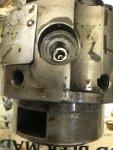stb64
Member
- 163
- 17
- 18
- Location
- hohenfels germany
Rustystud, I am not ''concerned'' with the droopscrew, I simply asked for clarification.Honestly I don't know why you are so concerned with the droop screw anyway.
You made two statements:
That the droopscrew :
1. helps add fuel and 2. prevents excessive fuel delivery
I fully agree with number 2, but do not understand how the droop screw could ever ''help add fuel''.
It is clear that these are two things that are exactly the opposite.That's what my question, still unanswered BTW, was all about.
I am a certified diesel mechanic, so there is no need to explain to me how the governor functions, I learned that decades ago.
I am very familiar with bosch injection pumps, so you will not have to explain the principles of operation.
You can go directly to the droop screw and tell me how it causes what part of the governor to move in which direction in order to add fuel.
I know exactly when and under what conditions the droop screw comes into contact with the stop plate, and when the smoke limit cam does, but neither do I see how having been an apprentice at m.a.n. should make me realize the stop plate is curved, nor how it should be related to the FDC, and I could not find such explanation in the pdf either.Now since you were an apprentice at M.A.N. then you should realize that since the stop plate is a "curved" and not straight piece of metal that at times the droop screw will come into contact before the "cam" will. That was explained in the PDF of the last post I gave you.
What I did see (and expected) is that the stop plate in the picture has two separate contact surfaces for the smoke cam and droop screw, having slightly different angles.
What I also see is that the pump in the picture is not a multifuel pump, and does not have a FDC. The governor operates on the same principle, however.
The code G pump's (LDS427-2) stop plate is perfectly straight. Smoke limit cam and droop screw are close together, and share the same contact surface.
The stop plates in the other multifuel injector pumps do also have two separate contact surfaces at slightly different angles.
If at all, the stop plate is rounded only where the 2 contact surfaces meet.
According to You, a droop screw ''has no more function'' with the FDC bypassed, as there are no more pressure changes, and the stop plate no longer moves, no longer causing surging.If you have bypassed the FDC like most people then it really has no more function for you
My explanation, back in post#109, of how the FDC works :
''The pressure inside the FDC only changes when a different fuel is used.
The pressure inside the FDC is the same regardless of engine speed, and does not change during engine operation.''
Differs from yours:
''I think I know what the problem is here. Your not taking into account that the stop plate moves during operation. It is not stationary, but slides up and down according to fuel pressure.''''The stop plate is continually being adjusted according to fuel pressure at that time. Since fuel pressure is adjusted according to engine RPM then that means the FDC is constantly adjusting''
Well, got the tm out, and found this:
''The fuel supply is admitted to a pressure regulating valve where the supply pressure is reduced to a constant regulated pressure over the engine operating speed and load range''
This means the stop plate does not move during engine operation, and even if it did, it would only change maximum load fuel by an negligible amount, between the full load gasoline position, and the full load diesel position.
So your explanations did not answer my question yet.
Oh, and don't get me wrong.
Please keep in mind that my questions are of purely technical nature.
I truly appreciate Your threads. Lots of useful step by step information and heads up even for more experienced mechanics.


